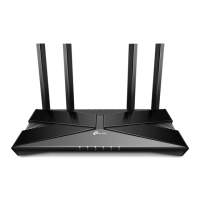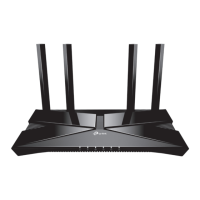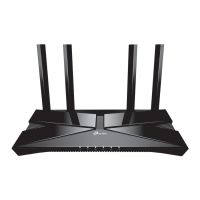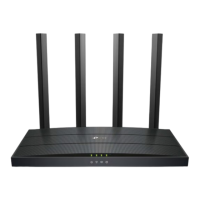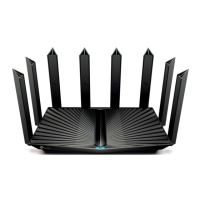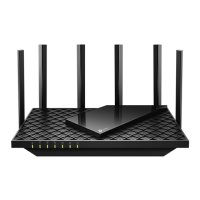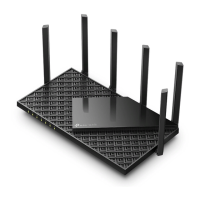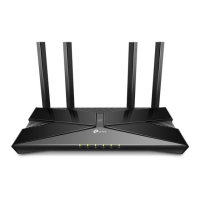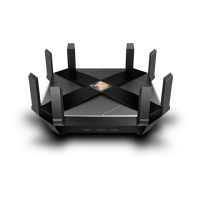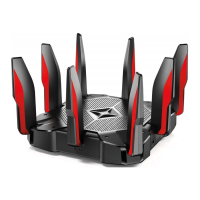Do you have a question about the TP-Link Archer AX50 and is the answer not in the manual?
Explains document conventions, symbols, and formatting used in the guide.
Details the TP-Link AX router's next-generation Wi-Fi 6 technology and features.
Illustrates the physical appearance of the router, including top and back panels.
Details the components and ports located on the back panel of the router.
Guidance on router placement and step-by-step physical connection instructions.
Explains how to connect computers and devices via Ethernet, Wi-Fi, or WPS.
Details the steps for accessing the router's web management interface via a browser.
Guides users through the router's automated internet setup process.
Instructions for configuring internet connection using the TP-Link Tether mobile application.
Detailed steps for manually configuring various internet connection types (Dynamic IP, Static IP, PPPoE, etc.).
Configures the router to function as an Access Point for an existing network.
Guides on configuring IPv6 internet connection types like PPPoE, Dynamic IP, Static IP, etc.
Step-by-step guide to registering for a TP-Link ID for cloud services.
Instructions for changing email address and password associated with your TP-Link ID.
Details on adding, removing, and managing user accounts for router access.
Instructions on how to manage the router remotely using the TP-Link Tether mobile application.
Enables users to create and configure a separate Wi-Fi network for guests.
Allows customization of guest network settings for security and privacy, such as client isolation.
Instructions for accessing files on a connected USB storage device locally from computers.
Methods for accessing USB storage remotely via FTP or network shares.
Personalizes USB access by setting server names, sharing specific folders, and authentication.
Enables sharing media files (photos, music, videos) from USB storage to DLNA devices.
Configures the router to support Apple's Time Machine for Mac backups to USB storage.
Allows setting internet access restrictions, time limits, and content filtering for family members.
Prioritizes network traffic for specific applications or devices to ensure smooth performance.
Provides built-in antivirus and intrusion prevention for the home network against threats.
Configures the SPI firewall to protect the router from cyber attacks and validate traffic.
Manages network access by blocking or allowing specific devices based on MAC addresses.
Prevents ARP spoofing and attacks by binding IP addresses to MAC addresses.
Configures virtual servers to share local resources and services with the internet.
Opens external ports dynamically based on connection to a triggering port for applications.
Sets up a PC as a DMZ host, exposing it to the internet for unlimited communication.
Enables UPnP to automatically manage ports for applications like online gaming and VoIP.
Guides on setting up an OpenVPN server for secure remote access to the home network.
Provides instructions for configuring a PPTP VPN server for remote access.
Allows modification of the router's LAN IP address and subnet mask.
Combines router ports to create a higher bandwidth wired connection for improved speed.
Configures the router to support IPTV services, including IGMP proxy and modes.
Manages the DHCP server settings, including IP address pools and reservations.
Configures DDNS to access the router remotely using a domain name.
Manually configures routing table entries for specific network destinations.
Allows customization of wireless network name (SSID), password, security, and other parameters.
Explains how to use WPS for easy and secure Wi-Fi connection setup.
Schedules the router's wireless network to turn on or off automatically at specific times.
Configures router system time and controls LED behavior for status indication and night mode.
Performs diagnostics like Ping and Traceroute to test network connectivity.
Guides on performing online or manual firmware upgrades for the router.
Allows backing up and restoring router configuration settings, including factory resets.
Configures scheduled reboots, administrator account changes, and password recovery.
Manages local and remote access to the router, including IP/MAC based controls.
Manages system logs, including saving them locally or sending them to a mailbox.
Configures advanced wireless parameters and NAT settings for network optimization.
Guides on configuring the router to work with Amazon Alexa via the TP-Link Router Skill.
Steps to recover a forgotten wireless network password.
Troubleshooting steps for inability to log in to the router's web management page.
Guides on resolving issues when the router cannot access the internet after setup.
Solutions for not finding wireless networks or failing to connect to them.
Details FCC compliance, RF radiation exposure limits, and operating conditions.
Covers CE marking, EU declaration of conformity, RF exposure, and national restrictions.
Information regarding Canadian compliance and Industry Canada statements.
Provides specific warning statements for Korea regarding radio frequency interference.
General safety guidelines, warnings, and explanations of product label symbols.
Explains document conventions, symbols, and formatting used in the guide.
Details the TP-Link AX router's next-generation Wi-Fi 6 technology and features.
Illustrates the physical appearance of the router, including top and back panels.
Details the components and ports located on the back panel of the router.
Guidance on router placement and step-by-step physical connection instructions.
Explains how to connect computers and devices via Ethernet, Wi-Fi, or WPS.
Details the steps for accessing the router's web management interface via a browser.
Guides users through the router's automated internet setup process.
Instructions for configuring internet connection using the TP-Link Tether mobile application.
Detailed steps for manually configuring various internet connection types (Dynamic IP, Static IP, PPPoE, etc.).
Configures the router to function as an Access Point for an existing network.
Guides on configuring IPv6 internet connection types like PPPoE, Dynamic IP, Static IP, etc.
Step-by-step guide to registering for a TP-Link ID for cloud services.
Instructions for changing email address and password associated with your TP-Link ID.
Details on adding, removing, and managing user accounts for router access.
Instructions on how to manage the router remotely using the TP-Link Tether mobile application.
Enables users to create and configure a separate Wi-Fi network for guests.
Allows customization of guest network settings for security and privacy, such as client isolation.
Instructions for accessing files on a connected USB storage device locally from computers.
Methods for accessing USB storage remotely via FTP or network shares.
Personalizes USB access by setting server names, sharing specific folders, and authentication.
Enables sharing media files (photos, music, videos) from USB storage to DLNA devices.
Configures the router to support Apple's Time Machine for Mac backups to USB storage.
Allows setting internet access restrictions, time limits, and content filtering for family members.
Prioritizes network traffic for specific applications or devices to ensure smooth performance.
Provides built-in antivirus and intrusion prevention for the home network against threats.
Configures the SPI firewall to protect the router from cyber attacks and validate traffic.
Manages network access by blocking or allowing specific devices based on MAC addresses.
Prevents ARP spoofing and attacks by binding IP addresses to MAC addresses.
Configures virtual servers to share local resources and services with the internet.
Opens external ports dynamically based on connection to a triggering port for applications.
Sets up a PC as a DMZ host, exposing it to the internet for unlimited communication.
Enables UPnP to automatically manage ports for applications like online gaming and VoIP.
Guides on setting up an OpenVPN server for secure remote access to the home network.
Provides instructions for configuring a PPTP VPN server for remote access.
Allows modification of the router's LAN IP address and subnet mask.
Combines router ports to create a higher bandwidth wired connection for improved speed.
Configures the router to support IPTV services, including IGMP proxy and modes.
Manages the DHCP server settings, including IP address pools and reservations.
Configures DDNS to access the router remotely using a domain name.
Manually configures routing table entries for specific network destinations.
Allows customization of wireless network name (SSID), password, security, and other parameters.
Explains how to use WPS for easy and secure Wi-Fi connection setup.
Schedules the router's wireless network to turn on or off automatically at specific times.
Configures router system time and controls LED behavior for status indication and night mode.
Performs diagnostics like Ping and Traceroute to test network connectivity.
Guides on performing online or manual firmware upgrades for the router.
Allows backing up and restoring router configuration settings, including factory resets.
Configures scheduled reboots, administrator account changes, and password recovery.
Manages local and remote access to the router, including IP/MAC based controls.
Manages system logs, including saving them locally or sending them to a mailbox.
Configures advanced wireless parameters and NAT settings for network optimization.
Guides on configuring the router to work with Amazon Alexa via the TP-Link Router Skill.
Steps to recover a forgotten wireless network password.
Troubleshooting steps for inability to log in to the router's web management page.
Guides on resolving issues when the router cannot access the internet after setup.
Solutions for not finding wireless networks or failing to connect to them.
Details FCC compliance, RF radiation exposure limits, and operating conditions.
Covers CE marking, EU declaration of conformity, RF exposure, and national restrictions.
Information regarding Canadian compliance and Industry Canada statements.
Provides specific warning statements for Korea regarding radio frequency interference.
General safety guidelines, warnings, and explanations of product label symbols.
| DSL WAN | No |
|---|---|
| Ethernet WAN | Yes |
| WAN connection type | RJ-45 |
| Wi-Fi band | Dual-band (2.4 GHz / 5 GHz) |
| Wi-Fi standards | 802.11a, 802.11b, 802.11g, Wi-Fi 4 (802.11n), Wi-Fi 5 (802.11ac), Wi-Fi 6 (802.11ax) |
| Top Wi-Fi standard | Wi-Fi 6 (802.11ax) |
| WLAN data transfer rate (max) | 3000 Mbit/s |
| WLAN data transfer rate (first band) | 574 Mbit/s |
| WLAN data transfer rate (second band) | 2402 Mbit/s |
| Networking standards | IEEE 802.11a, IEEE 802.11ac, IEEE 802.11ax, IEEE 802.11b, IEEE 802.11g, IEEE 802.11n |
| Receiver sensitivity | 5 GHz: 11a 6Mbps:-97dBm, 11a 54Mbps:-79dBm 11ac VHT20_MCS0:-96dBm, 11ac VHT20_MCS11:-66dBm 11ac VHT40_MCS0:-94dBm, 11ac VHT40_MCS11:-63dBm 11ac VHT80_MCS0:-91dBm, 11ac VHT80_MCS11:-60dBm 11ac VHT160_MCS0:-88dBm, 11ac VHT160_MCS11:-55dBm 11ax HE20_MCS0:-95dBm, 11ax HE20_MCS11:-63dBm 11ax HE40_MCS0:-92dBm, 11ax HE40_MCS11:-60dBm 11ax HE80_MCS0:-89dBm, 11ax HE80_MCS11:-58dBm 11ax HE160_MCS0:-85dBm, 11ax HE160_MCS11:-55dBm 2.4 GHz: 11g 6Mbps:-97dBm, 11a 54Mbps:-79dBm 11n HT20_MCS0:-97dBm, 11n HT20_MCS7:-78dBm 11n HT40_MCS0:-95dBm, 11n HT40_MCS7:-75dBm 11ac VHT20_MCS0:-96dBm, 11ac VHT20_MCS11:-67dBm 11ac VHT40_MCS0:-94dBm, 11ac VHT40_MCS11:-64dBm 11ax HE20_MCS0:-96dBm, 11ax HE20_MCS11:-64dBm 11ax HE40_MCS0:-93dBm, 11ax HE40_MCS11:-61dBm |
| Ethernet LAN data rates | 10, 100, 1000 Mbit/s |
| Ethernet LAN interface type | Gigabit Ethernet |
| Transmit power | CE: \u003C20dBm(2.4 GHz), \u003C23dBm(5.15 GHz~5.35 GHz); \u003C30dBm(5.47 GHz~5.725 GHz); FCC:\u003C30dBm(2.4 GHz & 5.15 GHz~5.825 GHz) dBmW |
| Antennas quantity | 4 |
| Product type | Tabletop router |
| Product color | Black |
| LED indicators | LAN, Power, Status, WAN |
| Output current | 2 A |
| Output voltage | 12 V |
| Power source type | AC |
| USB 3.2 Gen 1 (3.1 Gen 1) Type-A ports quantity | 1 |
| Firewall security | DoS, SPI |
| Supported network protocols | IPv4, IPv6 |
| Cables included | LAN (RJ-45) |
| Package depth | 240 mm |
| Package width | 330 mm |
| Package height | 73 mm |
| Package weight | 870 g |
| Number of products included | 1 pc(s) |
| Browser supported | Internet Explorer 11, Firefox 12.0, Chrome 20.0, Safari 4.0 |
| Windows operating systems supported | Windows 10, Windows 2000, Windows 7, Windows 8, Windows 8.1, Windows 98SE, Windows NT, Windows XP |
| Storage temperature (T-T) | -40 - 70 °C |
| Operating temperature (T-T) | 0 - 40 °C |
| Storage relative humidity (H-H) | 5 - 90 % |
| Operating relative humidity (H-H) | 10 - 90 % |
| Certification | CE, FCC, RoHS |
| Depth | 135 mm |
|---|---|
| Width | 260 mm |
| Height | 38.6 mm |
